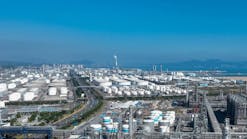The International Marine Organization (IMO) announced in October 2016 to limit sulfur content in all marine fuels from the current 3.5% to 0.5% as of 2020. The new rules loom ever closer, while the implementation of this regulation is still the subject of much debate and analysis.
Early this year, an IMO subcommittee announced a proposal to ban the carriage of noncompliant bunker fuel aboard ships that have not installed onboard scrubbers. IMO approved this proposal in April. This is another strong determination signaled by IMO to strictly enforce these new environmental regulations, leaving shippers and refiners scrambling to respond.
However, despite repeated assurances from IMO that there will be no delay to the start, one third of shipowners responding to the IMO 2020 survey of Drewry, an independent maritime research consultancy, indicated they are still not convinced a global 0.5% sulfur cap on marine fuel will come into effect as planned as of Jan. 1, 2020, due to a lack of readiness.
Opposing viewpoint
Market opinions on whether there will be enough supply of 0.5% product by 2020, the key of the IMO 2020, have been divided from the very beginning.
Studies of CE Delft, which were used as the basis of the IMO’s decisions in 2016, showed that in a base-case scenario, secondary refining unit expansions until 2020, along with higher run rates, should allow the sector to meet the projected increase in distillate demand.
However, a rival study from EnSys and Navigistics came to the opposing view that refining capacity will not be sufficient in 2020, estimating that 60-75% of additional sulfur plant capacity would need to be built by 2020 compared with planned projects.
A report from IHS Markit indicates that refining capacity will exist in 2020 to produce the low-sulfur bunker fuel, but higher overall crude runs will be required.
According to the latest MarPoll, a quarterly survey of Splash247, “46% of Splash readers believe there will not be enough low-sulfur fuel come Jan. 1, 2020, when the new IMO regulations kick in, with a slim majority, 54%, believing there will be enough to go around.
One respondent commented that supply constraints would likely surface as early as fourth-quarter 2019 and that the price of marine gas oil could double or even triple until the market stabilizes.
Winners and losers
Although it is still unclear how successful the new rules will be, the specification change will no doubt trigger a surge in middle distillate demand in 2020 while forcing demand for high-sulfur fuel oil to plummet.
In 2016, global demand for high-sulfur residual fuel oil from ship bunkers reached 3.3 million b/d out of 7.2 million b/d of total fuel oil demand. The new rules mean that refiners need to change 3 million b/d high-sulfur fuel oil into a comparable volume of compliant 0.5% sulfur bunkers, although the usage of scrubbers on smoke stacks may mitigate this figure.
Refineries that primarily make high-sulfur fuel usually lack the technology to convert that part of crude into higher-valued products like gasoline, jet fuel, or diesel. Or, the other way around, the high cost to reduce sulfur levels through employing refining technology has not been recoverable in the marketplace.
Although a cycle of capacity additions, distillation as well as conversion, driven by higher margins for more complex configuration, might be expected down the road, there is not enough time between now and 2020 to initiate large-scale IMO-focused refining investments.
In addition to the production of low-sulfur bunker fuel, refiners will face another primary challenge of the disposal of high-sulfur residual fuel. They will look for alternative markets like power generation or making asphalt.
There will be winners and losers. Those sophisticated ones or those that can produce a high percentage of distillate and gasoline from sour crude, such as US Gulf Coast refiners and the Middle East’s modern and flexible refineries, will be particularly advantaged, while simple refiners of sour crude will be negatively impacted. Refiners of sweet-crude conversion will likely have moderately higher margins.

Conglin Xu | Managing Editor-Economics
Conglin Xu, Managing Editor-Economics, covers worldwide oil and gas market developments and macroeconomic factors, conducts analytical economic and financial research, generates estimates and forecasts, and compiles production and reserves statistics for Oil & Gas Journal. She joined OGJ in 2012 as Senior Economics Editor.
Xu holds a PhD in International Economics from the University of California at Santa Cruz. She was a Short-term Consultant at the World Bank and Summer Intern at the International Monetary Fund.


